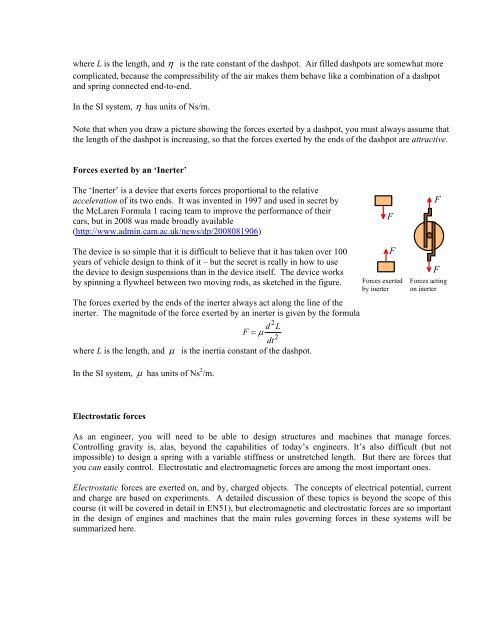Chapter 2 Review of Forces and Moments - Brown University
Chapter 2 Review of Forces and Moments - Brown University
Chapter 2 Review of Forces and Moments - Brown University
You also want an ePaper? Increase the reach of your titles
YUMPU automatically turns print PDFs into web optimized ePapers that Google loves.
where L is the length, <strong>and</strong> η is the rate constant <strong>of</strong> the dashpot. Air filled dashpots are somewhat more<br />
complicated, because the compressibility <strong>of</strong> the air makes them behave like a combination <strong>of</strong> a dashpot<br />
<strong>and</strong> spring connected end-to-end.<br />
In the SI system, η has units <strong>of</strong> Ns/m.<br />
Note that when you draw a picture showing the forces exerted by a dashpot, you must always assume that<br />
the length <strong>of</strong> the dashpot is increasing, so that the forces exerted by the ends <strong>of</strong> the dashpot are attractive.<br />
<strong>Forces</strong> exerted by an ‘Inerter’<br />
The ‘Inerter’ is a device that exerts forces proportional to the relative<br />
acceleration <strong>of</strong> its two ends. It was invented in 1997 <strong>and</strong> used in secret by<br />
the McLaren Formula 1 racing team to improve the performance <strong>of</strong> their<br />
cars, but in 2008 was made broadly available<br />
(http://www.admin.cam.ac.uk/news/dp/2008081906)<br />
F<br />
F<br />
The device is so simple that it is difficult to believe that it has taken over 100<br />
years <strong>of</strong> vehicle design to think <strong>of</strong> it – but the secret is really in how to use<br />
the device to design suspensions than in the device itself. The device works<br />
by spinning a flywheel between two moving rods, as sketched in the figure.<br />
The forces exerted by the ends <strong>of</strong> the inerter always act along the line <strong>of</strong> the<br />
inerter. The magnitude <strong>of</strong> the force exerted by an inerter is given by the formula<br />
2<br />
d L<br />
F = μ<br />
2<br />
dt<br />
where L is the length, <strong>and</strong> μ is the inertia constant <strong>of</strong> the dashpot.<br />
F<br />
<strong>Forces</strong> exerted<br />
by inerter<br />
F<br />
<strong>Forces</strong> acting<br />
on inerter<br />
In the SI system, μ has units <strong>of</strong> Ns 2 /m.<br />
Electrostatic forces<br />
As an engineer, you will need to be able to design structures <strong>and</strong> machines that manage forces.<br />
Controlling gravity is, alas, beyond the capabilities <strong>of</strong> today’s engineers. It’s also difficult (but not<br />
impossible) to design a spring with a variable stiffness or unstretched length. But there are forces that<br />
you can easily control. Electrostatic <strong>and</strong> electromagnetic forces are among the most important ones.<br />
Electrostatic forces are exerted on, <strong>and</strong> by, charged objects. The concepts <strong>of</strong> electrical potential, current<br />
<strong>and</strong> charge are based on experiments. A detailed discussion <strong>of</strong> these topics is beyond the scope <strong>of</strong> this<br />
course (it will be covered in detail in EN51), but electromagnetic <strong>and</strong> electrostatic forces are so important<br />
in the design <strong>of</strong> engines <strong>and</strong> machines that the main rules governing forces in these systems will be<br />
summarized here.
















